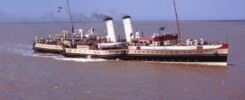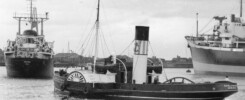
Glen Gower was about five nautical miles seaward of Ilfracombe at 5am on the morning of Friday 7th October 1938 on her way back to Bristol from Brighton. It had been a difficult and very windy passage.
She had set off from the Palace Pier Brighton at 9am on Monday 3rd October under the command of Captain Bruford in a freshening SW breeze interspersed with rainy squalls. She arrived alongside Ryde Pier at 12.40pm where 28 passengers disembarked and a further 5 came aboard for the long coastal voyage back to the Bristol Channel. She then proceeded down the Solent but by the time she was off Yarmouth around 2pm the wind was gusting gale force 8 so the decision was taken to hove to and go to anchor. The wind was so strong that the anchor kept dragging despite putting out more chain so it was hauled up and Glen Gower moved slightly closer to the lee of the shore and dropped anchor once again.
The following morning on Tuesday 4th October the gale was still blowing and it was noted that not only had the railway Channel Island ferry from Southampton been cancelled but also the Lymington/Yarmouth ferry was suspended. With the voyage being so extended it was clear that more coal and other supplies were going to be needed so at 2pm the anchor was hauled up and Glen Gower proceeded to Southampton to take stores.
The gale was still raging the next morning on Wednesday 5th October. Coal was loaded from 12 noon and with an apparent easing in the wind the decision was taken to sail at 3pm. By 4.30pm she was off Yarmouth and continued on down the Needles Channel with the Needles abeam shortly after 5pm. However the weather was too much for her and so she turned back with some difficulty in the mountainous seas and proceeded back in.
So at 6pm on Wednesday 5th October, Glen Gower dropped the hook once again to spend yet another night anchored off Yarmouth awaiting a lull in the wind.
The following morning, Thursday 6th October the wind was showing signs of decreasing so the anchor was hauled up at 6.45am and she proceeded down the Needles Channel and on out to sea with the wind now in the NW and still fresh. St Albans Head was passed at 8.40am, Portland Bill at 10.15am and Start point at 2pm. At 4.45pm another gale warning was received on the radio but Captain Bruford decided to keep going hoping to get round Lands End before the full force of the rising gale came upon them. The Lizard was abeam at 7.40pm and the Longships was rounded at 9.40pm with the wind still rising and the ship rolling heavily.
By 5.30am on the morning of Friday 7th October Glen Gower was about five miles out to sea off Ilfracombe and at 8.15am came to anchor off Minehead to await the tide. The anchor was hauled up at 1.05pm and Cardiff as reached at 2.35pm before proceeding on up the Avon to Bristol where she arrived at 4.55pm.
These details come from the records of Mr George Owen, who was a passenger aboard for this trip. He also reports that during this very gale laden week there were 85mph gusts of wind recorded, that bathing huts and the seafront were damaged at Bournemouth, a shop front was blown out at Southampton, that the bridge of the coaster Crewhill was washed away taking her master with it and that there was widespread damage across the country with many trees felled by the gale.
Kingswear Castle returned to service in 2023 after the first part of a major rebuild which is designed to set her up for the next 25 years running on the River Dart. The Paddle Steamer Kingswear Castle Trust is now fund raising for the second phase of the rebuild. You can read more about the rebuilds and how you can help if you can here.
John Megoran
This article was first published on 7th October 2020.


